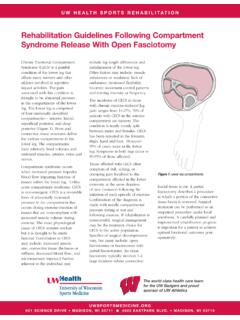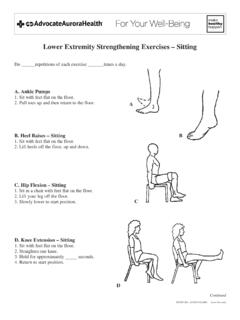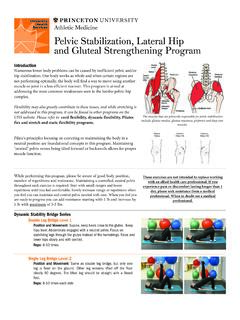Transcription of Exercises for the Lower Extremity Amputee, Beginning ...
1 Exercises for the Lower Extremity amputee , Beginning through advanced A Program for Regaining Optimal Function (1997) by William Partridge PT, Philip Kreuter PT, and Scott Belding PT Excerpted and edited from their booklet, reprinted with permission on March 13, 2014. Beginning STRETCHING Exercises Stretching helps keep both the sound and residual limbs flexible, will help to prevent injury, and make walking easier and more natural. The illustrations are guides, don t worry if you can t get into the position as shown. Hamstring stretch for BK amputee . Sit on floor with a book under heel of prosthetic leg. Push down on knee. Hamstring stretch. Sit on a bed or bench with the sound leg straight.
2 Bend the prosthetic leg over the side of the bed. Reach forward toward your foot with both arms, while bending from your hips (not your waist). Hip flexor stretch. Lie on your back on a bed, bench or table. Let your prosthetic leg hang off the side. Pull the opposite knee toward your chest with your hands. Calf Stretch. Stand facing a wall, with sound leg back and prosthetic leg front. Keep your sound heel on the floor. Put your hands against the wall and lean into the wall. Follow these general guidelines for exercise , whether at home, in physical therapy, or at the gym/health club. Consult your physician or physical therapist about the best Exercises for you, based on your level of health, medications, etc.
3 Do all Exercises with your prosthesis on, to train your muscles to work as they do when you walk. Check your prosthetic daily. Do Exercises slowly and with control. Avoid jerking. Concentrate on the muscle group being exercised. Start slowly. Build up gradually. Daily short sessions are better than long sessions to avoid injury. Do stretches daily, and before and after strengthening Exercises . Hold stretches for 20-30 seconds. Repeat each exercise 3-4 times. Increase the amount of stretch very gradually. A sustained stretch (held 20 seconds or longer) is more helpful than a ballistic (bouncing) stretch. Do strengthening exercise at least 3 times/week.
4 Start with only a few repetitions (ie, 5). Increase the weight or number of repetitions if and when the exercise feels too easy. No pain. Stop exercise that causes pain. Do not accept sharp or burning pain in the residual limb. If discomfort persists more than a few days, you may be exercising too hard or progressing too fast. Slow down. No redness or pressure. Check your residual limb often for redness or signs of pressure, especially in the first few weeks. A physician should see any minor injury not responding to routine treatment, and should see any acute injury immediately. Page 2 Stretching Exercises cont. Exercises for the Lower Extremity amputee , Beginning through advanced Hip flexor stretch #2.
5 Lie on your stomach on the floor. AKs lock your knee. Push upper body off floor as far as is comfortable, keeping hips on or close to the floor. Start with elbows bent, then straighten then if and when you are able. Hip flexor stretch #3. Lie on your stomach on the edge of a bed or bench. With your prosthesis side on the bed or bench, put your sound foot on the floor. Push up with your arms as in #2. Hip flexor stretch #4. Kneel on affected side (BKs use a pillow under the knee). Keep back straight. Rock forward, while pushing the back of the hip forward with the hand. advanced STRETCHING Exercises These advanced stretches are desirable when your activity level increases, and are especially helpful if you run or participate in recreational or competitive sports.
6 Quadricep stretch. Stand on your prosthetic leg. With your prosthetic-side hand, hold on to a balance bar to keep your balance. With your other hand, pull your heel toward your buttock until you feel a stretch in the front of the thigh. This exercise can also be done side-lying. Iliotibial Band (ITB) stretch. Cross prosthetic leg behind sound leg. Lean toward the sound side until you feel a stretch on the outside of your hip. The acronym RICE is helpful to remember when dealing with injuries. R is for Rest. Active Rest is a better term. This means avoiding activities that cause pain in the injured area. I is for Ice. Ice is an anesthetic, anti-inflammatory, and anti-swelling agent.
7 In the first 48 hours following injury, it can be used on ligaments, tendons, muscles and skin. To avoid frostbite, limit direct application to 10 minutes or insulate with a towel and limit to 15-20 minutes/hour. C is for Compression. Compression controls swelling and provides healing and stability. Use elastic bandages, tape or neoprene or nylon sleeve. For amputee athletes, compressing the residual limb when out of the prosthesis helps with shaping and desensitization. E is for Elevation. With swelling in an Extremity , elevation above the level of the heart promotes healing. Sports Medicine - Injuries. If you train long, you may suffer minor injuries.
8 2 common types are tendon overuse, and muscle strains. Ligament injuries occur more from sports injuries rather than from gym and rehab exercise . Page 3 strengthening Exercises Exercises for the Lower Extremity amputee , Beginning through advanced Move slowly into the position as illustrated. Hold it a few seconds. Relax. Repeat. The number of repetitions depends on your physical condition, consult your physical therapist. For the Exercises shown, lie on a flat surface, such as a firm bed or floor with an exercise pad. AKs with hydraulic knee should lock the knee. Leg lift #1. Strengthens hip flexors and quadriceps. Be sure to begin with sound leg bent and upper body raised in order to protect your Leg lift #2.
9 Strengthens hip extensors. Leg lift #3. Strengthens hip abductors Leg lift #4. Strengthens hip adductors. Beginning strengthening Exercises We now move from stretching to strengthening . Either beginner or advanced Exercises can be done at home with minimal equipment in 20-30 minutes. Increasing strength will help your gait, coordination, balance and overall function. AK amputee note: Important muscles you will be strengthening include hip extensors (gluts), hip abductors (for moving limb to the side), hip adductors (for moving limb inwards), and hip flexors. BK amputee note: Important muscles you will be strengthening include the quadriceps (thigh) and the hamstrings, as well as all hip muscles associated with the residual limb.
10 Sports Medicine Aids Topical creams, lotions, powders etc. may help minor pain, although they tend to treat the symptoms and not the underlying problem. Never use them with heat or ice. Get professional help with any persistent skin problem. Medicated powder may help skin irritations. Antihistamine cream may be used on a pink rash over the stump (unless it is the result of weight-bearing pressure). Second Skin reduces friction on the residual limb and may help with blisters. Triple Antibiotic cream helps heal skin irritations. NSAIDS may reduce pain, but follow dosage instructions. Braces, other than the sleeve type, require professional advice.








